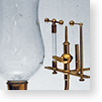
The tendency to quantify chemical phenomena reached its apex near the end of the 18th century, when it was discovered that atmospheric air was not a simple element but was made up of numerous gases. To analyze air and determine its chemical nature, highly sophisticated instruments were needed. Some of these devices were designed for applications of public usefulness: eudiometers, that measured the purity of air, and Volta's electric pistol (in which hydrogen was exploded in the presence of oxygen, obtaining water), forerunner of the hydrogen lamp.
Alkalimeter
Inv. 3911
Maker unknown, early 19th cent.
Barometer
Inv. 1143
Maker unknown, first half 19th cent.
Barometer
Inv. 1152
Nicolas Fortin, France, 1793
Bell-jar
Inv. 3792
Maker unknown, 18th cent.
Bell-jar
Inv. 1053
Maker unknown, 18th cent.
Bell-jars
Inv. 1047, 1048
Maker unknown, 18th cent.
Electric pistol, Volta type
Inv. 898
Maker unknown, ca. 1780
Electric pistol, Volta type
Inv. 897
Maker unknown, ca. 1780
Eudiometer
Inv. 930/b
Benjamin Martin, London, ca. 1780
Eudiometer
Inv. 930/a
George Adams junior, London, late 18th cent.
Eudiometer
Inv. 1371
Maker unknown, 1776
Evaerometro
Inv. 3913
Felice Fontana, 18th cent.
"Monesiglio" bottle
Inv. 356
Maker unknown, Italian, 18th cent.
Pressure receiver or de Morveau's disinfection apparatus
Inv. 3778
Maker unknown, early 19th cent.
Rumford's thermoscope
Inv. 1774
Maker unknown, first half 19th cent.
Volta hydrogen lamp
Inv. 1243
Maker unknown, ca. 1790
Voltaic detonating-gas eudiometer
Inv. 1627
Maker unknown, ca. 1790

























